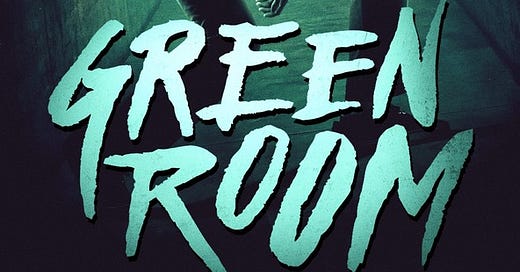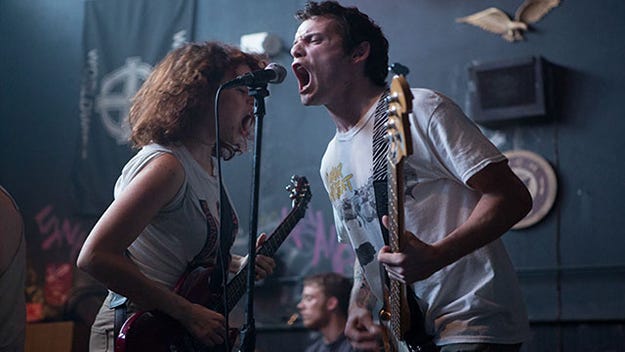The Favourites
Green Room is a masterpiece of suspense, while also being one of the best indicators of social unrest that was brewing underneath western culture in the mid-2010s. While on its surface it is a very simple film, an Assault on Precinct 13 style defense film about the ill-prepared versus the highest levels of human evil, underneath its frenzied destruction is a clear allegory of the truths and lies we are told by ourselves and others. A film about two different ideas of identity, and how it is in truth that we find actual salvation while lying to ourselves about our freedoms can lead us to ruin. All that, and a hand almost getting chopped off with a machete.
A set up so obvious it’s almost amazing that it took until 2015 for a major motion picture to take it on, a film about punks squaring off against Nazis has many different attributions that make it a dynamic confrontation. While it’s the differences that stand out upon first comparison (right-wing fascism vs. left-wing socialism) it’s the similarities that are more interesting within this film. Both groups function strongly on a DIY community sensibility, on the belief that it is better to take one’s own path than to conform to a mainstream ideal. Both have strong, loud, aggressive ideologies that do not bow easily to public pressure. It is when these ideologies are stressed, though, that the strength of these claims of community and freedom are tested.
The Ain’t Rights approach the world practically. In every situation they are in they try and see clearly and efficiently as possible, as much like a good hardcore song you only have ninety seconds to make your stance. We see this play out at first in simple, everyday things - siphoning gas to make it to the next town, sleeping on floors, taking gigs wherever they can find them. Even their anti-social media ideas play into this, as they are all about the singular moment. This translates into how they act when threatened; they talk out each move as much as they can, while being well aware that time is running out for them and that they are outnumbered and out-gunned. This then bleeds over into the “island bands” conversation, as when first proposed they give stereotypical “punk” answers. It is when the pressure is on and they know that decisions are now life and death that they allow themselves the pure freedom of giving truer (if lamer) answers. The punk approach to DIY is truth, it’s thinking for oneself and questioning every option available.
Compare this to the Nazi ideas of DIY, which is not a system of the self but of the group. They are anti-government, self-sustaining, but only if you follow the government of their own hierarchy. They claim to want the freedom to do (and hate) whatever they want, but they are confined to thinking within the rules set out by their leader. If you look to think for yourself while within this dynamic it only spells disaster, as with the deaths of Daniel and Werm. And if you stay within those rules, you are bound to the consequences of your leader’s failures. The Nazis lose because they either kill those who think for themselves or are killed because they are incapable of such a feat. It is a doomed pyramid scheme of ideology,.
This contrast in conformity is foreshadowed by the bands’ performance of ‘Nazi Punks Fuck Off’ bu the Dead Kennedys. The punks take the stage in a strange place and try to be as provocative as possible, outing themselves as true outsiders. The gathered Nazis at first react as expected, with vitriol, but it’s only momentary. As the band’s set continues the crowd loses themselves to the music, shedding their identity and choosing the enjoyment of the music over their political stance. They are not individuals but a collective, ready to be led in their beliefs and easily swayed. Later in the night, Darcy states that “this is a movement, not a party” to the departing crowd, but this is false. For the majority of those in his circle, Darcy is just the momentary figurehead, the “movement” nothing but a passing fad.
Conformity vs. true individualism is taken to its natural climax in the final act of the film. With only two of the punks remaining (Pat and Amber) they take on the physical attributions of the Nazis, and then make the choice the Nazis never could: to purposefully act crazy, to truly unconform. The Nazis, unable to contextual pure nonconformity, confused and distressed, are left as lambs to the slaughter. They are unable to conceive of what they are seeing, of the nonconformity they have been promised by their leader, and that leads to their doom. This is followed by Darcy and his remaining men also seeing what it means to be independent, and, unwilling to confront it, they choose death.
Despite all the mayhem, the final moments of the film provides us with a tiny glimmer of hope in the form of man’s best friend. Throughout the film, our protagonists have had vicious dogs sicced on them, with two members being mauled to death. Yet in the final scene, we see the lone survivor of these dogs not attacking our surviving couple. He poses no threat, and instead returns to his owner and mourns that man’s death. With this, we see that the evil of the Nazi ideology is not innate. The dog is not an evil creature but one that was trained to attack. Remove that training, separate it from the poisonous ideas that had been its leaders, and it can be reformed. There is hope, even for those we consider to be most lost.




